Imagine a massive earthquake has struck Vancouver, all but one of the cities bridges are down, someone is dangling from that bridge and patients are trapped beneath the rubble of a collapsed hospital.

There’s no power or cellphone service, hundreds of casualties, the airport is closed and landslides have covered the Sea to Sky Highway.
Window shards blanket the City of Glass.
The scenario is bleak, but all part of an urban disaster simulation conducted Saturday by members of Canada’s Task Force and Disaster Response team.
Making up that team are Vancouver’s Heavy Urban Search and Rescue, or Canada Task Force 1, as well as heavy urban search and rescue teams from Alberta and Manitoba and fire department staff from Vancouver, Burnaby, New Westminster and Coquitlam.
Although the team performs a disaster simulation once a year to teach first responders how to cope in real life catastrophes, this one was a little unusual.
City officials trucked in more than 2,000 tonnes of rubble and debris from the construction on the new Port Mann Bridge to replicate the collapse of St. Mary’s Hospital.
A smashed up transit bus and several crushed cars also lay among the debris. Search and rescue dogs leaped up over exposed pipes, slabs of concrete and bits of wood to seek out sounds.
On Saturday, rescue teams had already been working around the clock to save the patients. Tubing and generators pumped fresh oxygen into the open spaces of the debris piles.

Get breaking National news
The exercise seemed eerily real, as though the Big One had finally hit the Lower Mainland.
One man shouted into the debris, “There’s a rescuer coming in,” while a paramedic was informed in a serious tone that one of the trapped patients had become unconscious.
In one scenario, teams cut the mid-section out of a burned out car, wedged under the debris and set up shoring to stabilize the rubble before attempting the rescue.
From the tunnel they pulled out a female patient, made up to look like she was bleeding from the head, and helped her onto a stretcher before taking her to an ambulance.
Dan Hutchinson, a member of the team from Calgary and site leader, said crews had been working since 1 a.m. It can take up to 15 hours to rescue a person, he said.
“They could be in a void space, if there’s nothing hurting them and there’s nothing wrong they could just be trapped, or they could be injured. It depends on the injury as to how long they will last before rescue can get there.”
At a simulated disaster media briefing, deputy fire chief Wade Pierlot ran through the events.
At 10:18 a.m. Thursday a magnitude 7.3 earthquake hit Vancouver.
About 75 members from three task forces that make up the team from B.C., Alberta and Manitoba were notified and within six hours had mobilized.
Many of the members don’t know the simulation is going to happen, in an effort to make the disaster as real as possible, he said.
“It took us about 12 hours to get our emergency plan implemented and up and running in the city of Vancouver,” said Pierlot.
He said intelligence began coming in across satellite radios from six disaster operation zones throughout the city, and they had reports of 300 wounded.
“We realized that we had many fires burning, gas leaks, critical infrastructure was down, roadways, networks. We learned that YVR was down and Abbotsford was up and running. There was a lot of confusion. ”
Pierlot said 12 hours was “an excellent response time” to get people up and running. “You’ve got to be prepared before you can go out and help people,” he said.
Several rescue simulations were undertaken Saturday including a daring high angle rescue from the Burrard Street Bridge.
Rescue teams were told to help save a worker trapped on the bridge. During the simulation, a rescuer attached himself to the worker with a harness and repelled off the bridge and down approximately 30 metres to a fireboat waiting in the waterway below.
At the operations base, erected in southeast False Creek, tents were set up for showers, medical attention, and sleeping quarters for the crews.
Members have to be self-sustaining for 10 days, which means they bring generators, food, water and medical supplies.
“We can generate our own oxygen we can do our own surgery, we have doctors and paramedics here at all times,” said Scott Cowan, member of the Canadian Task Force and Disaster Response Team.
Added task force leader John Dennis:
“We have surgeons here, we could do amputations right here on site if we had to.”
Vancouver’s Task Force 1 is made up of 126 members from Vancouver Fire and Rescue Services, police, city staff and the B.C. Ambulance Service.







Comments